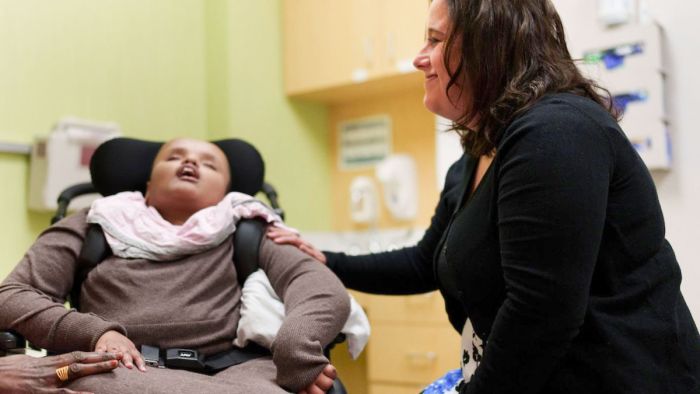A child having a seizure can be a scary experience, but Gillette Children’s team of internationally recognized pediatric neurology professionals are here to help. November is Epilepsy Awareness Month, so we spoke with pediatric neurology expert Janelle Pasch-Berglund, PNP, APRN, CNP, about what seizures in children often look like and what to do during and after your child has a seizure.
If your child is having a seizure for the first time, if you need assistance, or if you feel that the situation is unsafe, call 911.
What are the most common types of seizures in children?
The most common types of seizures we see in children, and the way they typically appear, include:
- Absence seizures: staring off, possible fluttering eyelids
- Generalized tonic-clonic (formerly known as grand mal) seizures: the person’s body is stiff and shaking
- Focal seizures: changes to the person’s motor and sensory functions as well as their awareness level. Focal seizures can sometimes lead to tonic-clonic seizures.
Seizures usually show the same signs in children with epilepsy and those without. A complete diagnostic evaluation by a trained pediatric neurology expert can help find the cause of the seizures.
What should I do if I think that my child might have a seizure disorder?
If you suspect that your child might have a seizure disorder, you should talk with their primary care provider. If needed, a primary care provider can make a referral to a pediatric neurology provider.
What should I do if my child has a seizure?
If your child regularly has seizures or has been diagnosed with epilepsy or another seizure disorder, here's what you can do:
- Let their body move. Do not try to restrain or restrict the movement of a child having a seizure.
- If your child experiences a change in their awareness or appears to not be awake, place them onto their side in a safe area. This will help keep their airway open during the seizure.
- Keep track of the length of the seizure by timing it (use the timer on your phone or watch the clock).
- Never place anything—fingers, liquids, foods—in your child’s mouth while they are having a seizure, or immediately after the seizure if they are unconscious. (See the next bullet point for an exception.)
- Some children are prescribed seizure rescue medication for prolonged seizure activity. The seizure rescue medication is the only thing that should ever be placed in a child’s mouth until they are fully awake and aware.
What should I do after my child has a seizure?
After your child has a seizure, there are several steps you can take to help them feel better physically, mentally, and emotionally.
- Put them in a safe area to recover.
- Keep an eye on them in case of aftereffects or more seizure activity.
- Make sure that they respond to stimuli by blowing air in their face, rubbing their cheek, or gently pinching their fingertip.
- Know that your child may be tired and need to rest – having a seizure is a lot of work! Their muscles may be sore and weak, depending on the type and length of the seizure.
- Seek medical care if this is the first time your child has had a seizure, so that you can have a plan in place going forward.
What sets Gillette Children's apart in pediatric neurology care?
Not only does Gillette Children’s boast a clinic specifically aimed at evaluating a child’s first seizure, our team of internationally recognized neurologists and advanced practice providers create and adjust treatment plans according to each individual patient’s unique needs. Our neurology providers aim to see new patients within four weeks of their referral, so children and their families are not waiting for answers for an extended period of time. This allows us to get a care plan in place and can set the patient’s and their fam
 Home Page
Home Page

